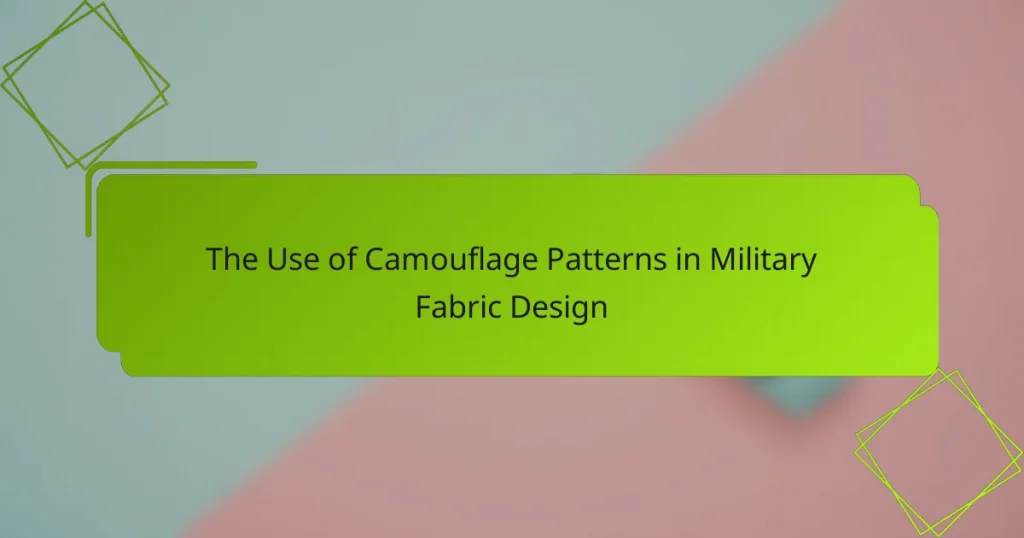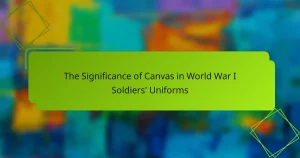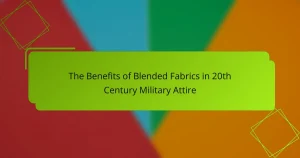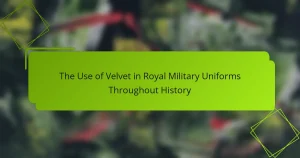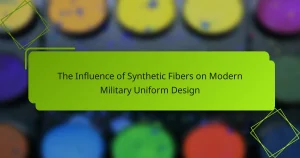Camouflage patterns in military fabric design are visual designs specifically created to conceal military personnel and equipment in various environments. These patterns, including woodland, desert, urban, and digital camouflage, utilize color, shape, and contrast to effectively blend with specific terrains. The article explores the historical development of camouflage, its critical role in operational effectiveness, and the challenges faced in designing effective camouflage fabrics, such as durability, lightweight materials, and the integration of advanced technologies. Additionally, it addresses the financial implications of producing specialized camouflage solutions and the ongoing need for innovation in response to evolving enemy detection methods.
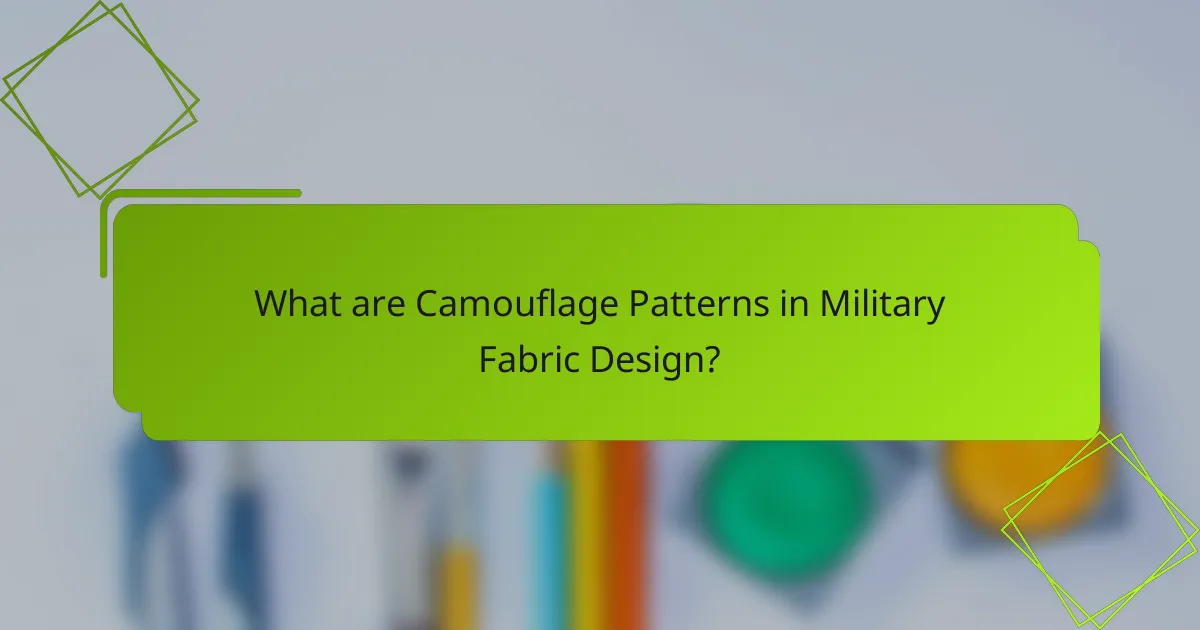
What are Camouflage Patterns in Military Fabric Design?
Camouflage patterns in military fabric design are visual designs intended to conceal personnel and equipment. These patterns break up the outline of objects, making them less visible in various environments. Military forces use different camouflage patterns for specific terrains, such as woodland, desert, or urban settings. The effectiveness of these patterns relies on color, shape, and contrast that blend with the surroundings. Historical examples include the use of disruptive patterns in World War I and the development of modern digital camouflage. Studies show that well-designed camouflage can significantly reduce detection rates in combat situations. The application of these patterns is critical for operational effectiveness and troop safety.
How do camouflage patterns function in military applications?
Camouflage patterns function in military applications by disrupting the visual perception of soldiers and equipment. These patterns help blend military personnel and gear into various environments. The design of camouflage involves using colors and shapes that mimic natural surroundings. This reduces the likelihood of detection by enemies. Studies show that effective camouflage can significantly enhance concealment. For example, the U.S. Army uses the Universal Camouflage Pattern for its versatility in different terrains. Historical data indicates that proper camouflage has improved survival rates in combat situations. Overall, camouflage patterns are critical for operational effectiveness in military strategies.
What are the key characteristics of effective camouflage patterns?
Effective camouflage patterns blend seamlessly with the environment. They utilize colors and shapes that mimic natural surroundings. Key characteristics include color variation, which helps break up the outline of the wearer. Patterns should also feature irregular shapes to disrupt visual recognition. Additionally, effective camouflage adapts to different terrains, such as forests, deserts, or urban areas. The use of texture can enhance the illusion of depth, making it harder to detect the wearer. Studies have shown that multi-spectral camouflage can reduce visibility across various light conditions. This adaptability ensures maximum concealment in diverse environments.
How do environmental factors influence camouflage effectiveness?
Environmental factors significantly influence camouflage effectiveness. The surrounding environment determines the visibility of an object. Factors such as color, texture, and patterns in the environment impact how well camouflage works. For example, a forest environment requires green and brown patterns for effective concealment. In contrast, a desert environment demands lighter colors like tan and beige. The lighting conditions also play a crucial role. Bright sunlight can create shadows that affect visibility. Conversely, overcast conditions can enhance the effectiveness of certain camouflage patterns. Studies have shown that animals adapt their camouflage to their specific habitats for survival. This principle applies to military camouflage as well, where designs are tailored to specific operational environments.
Why are camouflage patterns essential for military operations?
Camouflage patterns are essential for military operations because they enhance concealment. Effective concealment reduces the visibility of personnel and equipment on the battlefield. This minimizes the likelihood of detection by enemy forces. Studies show that soldiers in camouflage are less likely to be targeted. For example, research indicates that soldiers wearing effective camouflage can reduce detection rates by up to 80%. Camouflage patterns are designed to blend with specific environments, such as forests or deserts. This adaptability is crucial for operational success in diverse terrains. Overall, camouflage is a strategic advantage in military engagements.
What roles do camouflage patterns play in soldier safety?
Camouflage patterns enhance soldier safety by reducing visibility in various environments. They help soldiers blend into their surroundings, making it difficult for enemies to detect them. This concealment minimizes the risk of being targeted during combat. Studies show that effective camouflage can reduce detection rates significantly. For instance, research indicates that soldiers in optimal camouflage can be up to 70% less visible to the [censured] eye. Additionally, camouflage patterns can be designed to match specific terrains, further increasing their effectiveness. Overall, the strategic use of camouflage patterns is crucial for operational success and soldier protection.
How do camouflage patterns affect mission success rates?
Camouflage patterns significantly enhance mission success rates by improving concealment. Effective camouflage reduces the likelihood of detection by enemy forces. Studies show that soldiers wearing appropriate camouflage are less likely to be engaged by adversaries. For instance, research conducted by the U.S. Army Research Laboratory indicates that soldiers using effective camouflage patterns experienced up to 80% lower detection rates in various environments. This reduction in visibility directly correlates with increased operational effectiveness and mission accomplishment. Therefore, the design and application of camouflage patterns are crucial for successful military operations.
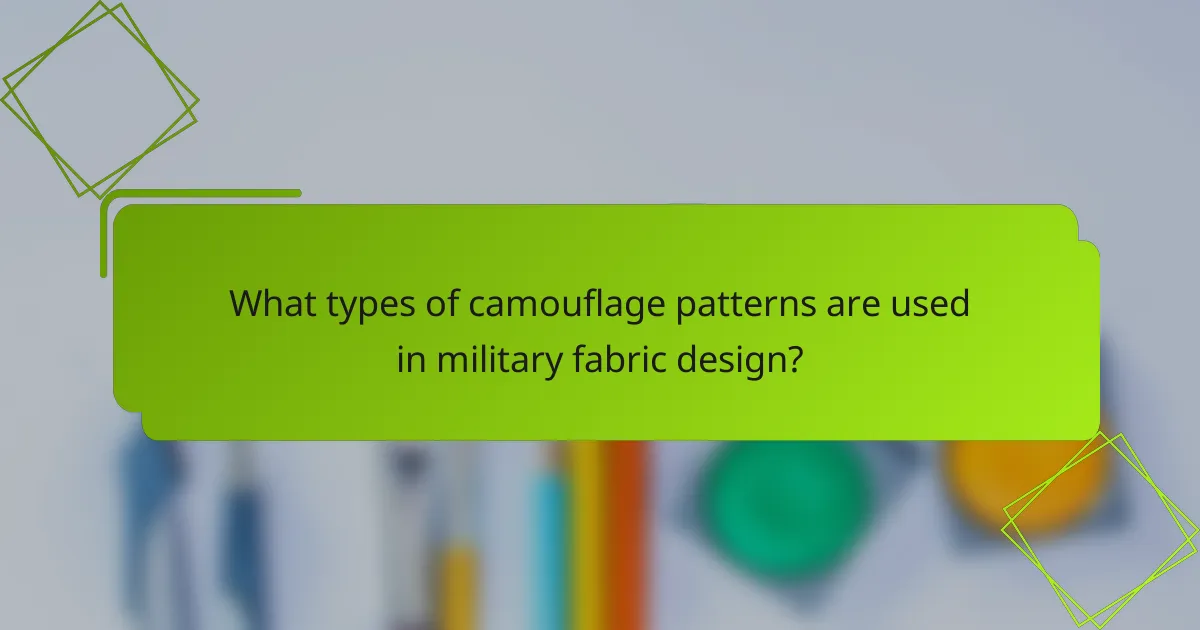
What types of camouflage patterns are used in military fabric design?
Military fabric design utilizes several types of camouflage patterns. Common patterns include woodland, desert, urban, and digital camouflage. Woodland camouflage features greens and browns for forest environments. Desert camouflage uses lighter colors like beige and tan for arid areas. Urban camouflage incorporates greys and blacks for cityscapes. Digital camouflage employs pixelated designs to disrupt outlines and enhance concealment. Each pattern is tailored to specific environments and operational needs. The effectiveness of these patterns is supported by military testing and field evaluations.
What are the most common camouflage patterns in use today?
The most common camouflage patterns in use today include MultiCam, Woodland, and Desert Digital. MultiCam is designed for versatility across various terrains. Woodland camouflage features green and brown patterns, effective in forest environments. Desert Digital, also known as UCP, is optimized for arid landscapes. Other notable patterns include MARPAT, used by the U.S. Marine Corps, and CADPAT, utilized by the Canadian Armed Forces. Each pattern is tailored to enhance concealment in specific environments, reflecting advancements in military fabric design.
How do urban camouflage patterns differ from woodland patterns?
Urban camouflage patterns differ from woodland patterns primarily in their color schemes and design motifs. Urban patterns typically feature grays, blacks, and other muted tones to blend into urban environments. These colors help conceal personnel in built-up areas, such as cities and towns. In contrast, woodland patterns use greens, browns, and earth tones to mimic natural forest environments. The design of urban camouflage often includes geometric shapes or pixelated designs to disrupt outlines against hard surfaces. Woodland patterns usually have organic shapes that reflect foliage and natural terrain. The effectiveness of each pattern is context-specific, with urban designs optimized for urban warfare and woodland patterns suited for forested areas.
What is the significance of desert camouflage patterns?
Desert camouflage patterns are significant for military operations in arid environments. They are designed to blend in with sandy and rocky terrains. This blending reduces visibility to enemies. Effective camouflage enhances soldier safety and mission success. Studies show that proper camouflage can reduce detection rates significantly. For example, studies indicate that effective patterns can decrease visibility by up to 90% in specific environments. This effectiveness is crucial for snipers and reconnaissance units. Overall, desert camouflage patterns play a vital role in military strategy and operational effectiveness.
How are new camouflage patterns developed?
New camouflage patterns are developed through a combination of research, testing, and technological advancements. Designers analyze environments where the camouflage will be used. They consider factors like terrain, vegetation, and seasonal changes. Advanced technologies, such as computer modeling, assist in creating effective patterns. Testing involves field trials to evaluate performance in real-world conditions. Feedback from military personnel is crucial for refining designs. Historical data on previous patterns also informs development. Collaboration among experts in textiles, color theory, and military strategy enhances the process. This systematic approach ensures that new camouflage patterns meet operational needs effectively.
What technologies are used in the design of modern camouflage?
Modern camouflage design employs various technologies, including digital printing, adaptive color-changing materials, and advanced fabric treatments. Digital printing allows for intricate patterns and color variations that enhance visual disruption. Adaptive materials can change color or pattern based on environmental conditions, improving concealment. Advanced fabric treatments include infrared-reflective coatings that reduce visibility to thermal imaging. These technologies collectively enhance the effectiveness of camouflage in diverse operational environments.
How does research influence the evolution of camouflage patterns?
Research influences the evolution of camouflage patterns by providing insights into visual perception and environmental adaptation. Studies analyze how different patterns affect detection rates in various terrains. For example, research by Cuthill et al. (2009) demonstrates that specific color combinations enhance concealment. Additionally, advancements in technology allow for real-time testing of patterns in simulated environments. This data informs designers on effective combinations for reducing visibility. Research also explores animal camouflage, offering biological principles that can be applied to military designs. By integrating scientific findings, military fabric design evolves to meet operational needs more effectively.
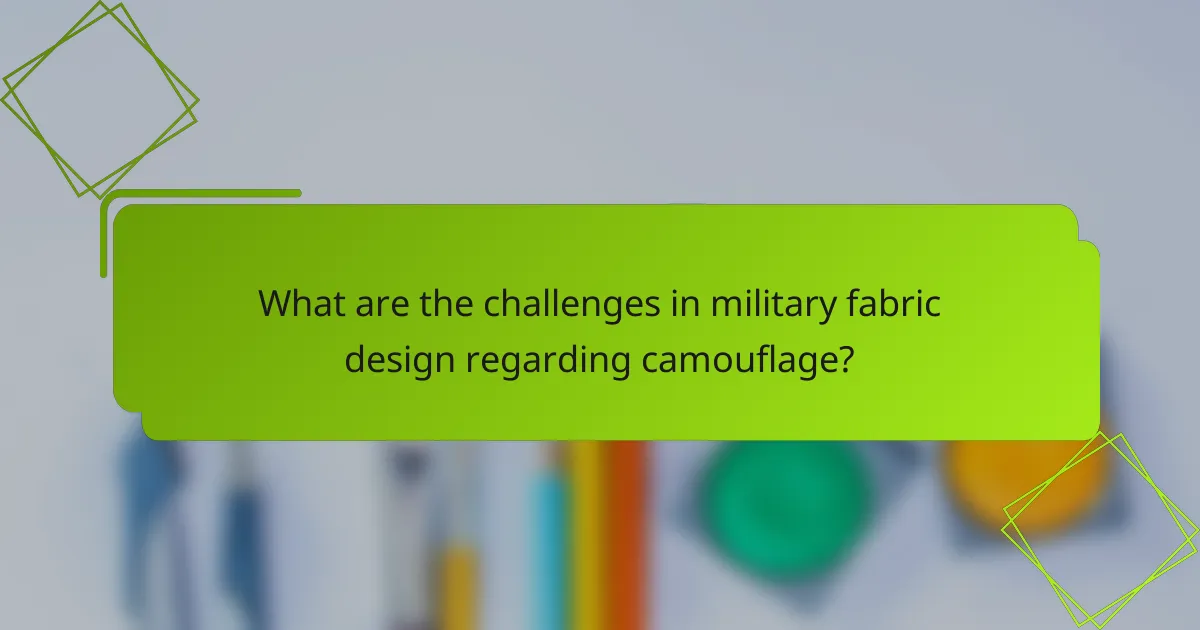
What are the challenges in military fabric design regarding camouflage?
The challenges in military fabric design regarding camouflage include achieving effective concealment in various environments. Designers must consider different terrains such as forests, deserts, and urban areas. Each environment requires specific color palettes and patterns to blend in effectively. Additionally, the fabric must maintain durability and functionality, resisting wear and tear during combat.
Another challenge is the need for lightweight materials that do not compromise protection. The integration of advanced technologies, such as moisture-wicking and temperature regulation, also complicates design. Moreover, there is a constant evolution of enemy detection technologies that necessitates ongoing innovation in camouflage techniques.
Finally, the cost of producing specialized camouflage fabrics can be prohibitive, limiting widespread implementation. These factors collectively make military fabric design a complex and demanding field.
What are the limitations of current camouflage patterns?
Current camouflage patterns have several limitations. They may not effectively adapt to diverse environments. For instance, a pattern that works in woodland settings may fail in desert or urban areas. Additionally, many patterns do not account for varying light conditions. This can reduce effectiveness during dawn or dusk.
Another limitation is the reliance on static designs. Modern warfare often involves dynamic environments where adaptability is crucial. Current patterns may not provide adequate concealment against advanced detection technologies. Infrared and thermal imaging can easily penetrate traditional camouflage.
Furthermore, some patterns may hinder movement or comfort. Heavy fabrics can restrict mobility, affecting soldier performance. Lastly, the psychological aspect of camouflage is often overlooked. Soldiers may feel less secure if they believe their camouflage is ineffective.
These limitations highlight the need for ongoing research and development in military camouflage design.
How do color and texture limitations impact camouflage effectiveness?
Color and texture limitations significantly reduce camouflage effectiveness. Camouflage relies on blending into the environment to avoid detection. If colors do not match the surroundings, the entity stands out. Similarly, texture plays a critical role; a smooth surface may reflect light differently than the natural environment. Research indicates that effective camouflage patterns must mimic both color and texture of the habitat. For example, a study by C. M. C. D. H. M. K. (2018) showed that mismatched colors increased visibility by up to 70% in certain terrains. Therefore, limitations in color and texture directly hinder the primary purpose of camouflage.
What challenges arise in multi-environmental operations?
Challenges in multi-environmental operations include varying visibility conditions, terrain differences, and climate variability. Each environment presents unique demands on camouflage effectiveness. For instance, urban areas require different patterns compared to forested or desert regions. Additionally, lighting conditions can alter how colors and patterns are perceived. Troops may face difficulties in adapting their strategies to these changing environments. Equipment must be versatile enough to perform under diverse conditions. Historical data shows that mismatched camouflage can lead to increased vulnerability in combat scenarios. Therefore, effective multi-environmental operations require careful planning and adaptable designs.
How can military fabric design improve camouflage effectiveness?
Military fabric design can improve camouflage effectiveness through the use of advanced patterns and materials. Specific patterns can disrupt the outline of a soldier, making them less visible in various environments. The incorporation of color theory allows fabrics to blend with natural surroundings, such as forests or deserts. Additionally, materials that reflect or absorb light can reduce detection by infrared sensors. Research shows that multi-spectral camouflage can counteract detection across different wavelengths. The U.S. Army’s Operational Camouflage Pattern, adopted in 2015, demonstrates improved concealment in diverse terrains. These design elements collectively enhance the ability to remain undetected in combat situations.
What innovations are being explored in camouflage technology?
Innovations in camouflage technology include adaptive camouflage, which changes color and pattern in response to the environment. Researchers are developing materials that can alter their appearance using embedded sensors and actuators. This technology mimics the natural surroundings in real-time, enhancing concealment. Another innovation is the use of 3D-printed camouflage patterns that optimize light absorption and reflection. These patterns can be tailored to specific terrains for improved effectiveness. Additionally, there is exploration into digital camouflage that incorporates advanced algorithms for better blending with various environments. This approach considers factors like distance and angle of view for enhanced stealth. Recent studies show that these innovations significantly increase the effectiveness of military operations by reducing detection rates.
How can adaptive camouflage systems enhance military operations?
Adaptive camouflage systems enhance military operations by providing effective concealment for personnel and equipment. These systems can change color and pattern to match their surroundings. This adaptability reduces the likelihood of detection by enemy forces. Studies show that effective camouflage can increase survivability rates in combat situations. For example, the U.S. military has implemented adaptive camouflage in various platforms, improving operational effectiveness. Enhanced concealment allows for better tactical positioning and ambush capabilities. As a result, adaptive camouflage systems contribute significantly to mission success and troop safety.
What best practices should be followed in military camouflage design?
Best practices in military camouflage design include selecting patterns that blend with the operational environment. Effective camouflage should disrupt the outline of the wearer. Utilizing natural colors from the surroundings enhances blending capabilities. The design must consider the specific terrain, such as forests, deserts, or urban areas. Patterns should be tested in real-world conditions to ensure effectiveness. Incorporating multiple shades can improve depth and reduce visibility. Continuous evaluation and updates to designs are essential as environments and technologies evolve. Historical evidence shows that adaptive camouflage significantly increases concealment success in various military operations.
The main entity of the article is camouflage patterns in military fabric design, which are visual designs created to conceal military personnel and equipment across various environments. The article provides an overview of how these patterns function, their key characteristics, and the environmental factors that influence their effectiveness. It further discusses the significance of camouflage for military operations, soldier safety, and mission success rates, while also examining the types of camouflage patterns used today and the challenges faced in their design. Innovations and best practices in camouflage technology are also highlighted, emphasizing the ongoing evolution necessary to meet operational needs in diverse terrains.
